The Snowball Effect: Communication Techniques to Make You Unstoppable
by Andy Bounds
The Accidental Indexer
by Nan Badgett
The Glass Cage: Automation and Us
by Nicholas Carr
Qualitative Text Analysis: A Guide to Methods, Practice & Using Software
by Udo Kuckartz
Designing News: Changing the World of Editorial Design and Information Graphics
by Francesco Franchi
Practical Empathy: For Collaborating and Creativity in Your Work
by Indi Young
A Century of Communication Studies: The Unfinished Conversation
by Pat J. Gehrke and William M. Keith, eds.
Writing for the Web: Composing, Coding, and Constructing Web Sites
by J. D. Applen
Scientific Writing and Communication: Papers, Proposals, and Presentations
by Angelika H. Hofmann
Josef Müller-Brockmann: Poster Collection 25
by Bettina Richter and Museum für Gestaltung Zürich, eds.
Revising and Editing for Translators
by Brian Mossop
Health Communication: Theory, Methods, and Application
by Nancy Grant Harrington, ed.
Nicely Said: Writing for the Web with Style and Purpose
by Nicole Fenton and Kate Kiefer Lee
Content Audits and Inventories: A Handbook
by Paula Ladenburg Land
KISS MY (?) Asterisk: A Feisty Guide to Punctuation and Grammar
by Jenny Baranick
Does Your Content Work? Why Evaluate Your Content — and How to Start
by Colleen Jones
Technology Integration and High Possibility Classrooms: Building from TPACK
by Jane Hunter
The Snowball Effect: Communication Techniques to Make You Unstoppable
Andy Bounds. 2013. West Sussex, United Kingdom: Capstone. [ISBN 978-0-857-08397-5. 282 pages, including index. US$22.00 (softcover).]
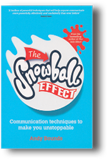 Bounds has a unique background that enables him to be an outstanding communicator and author. He attributes his mother's blindness to his lifetime of experience communicating from someone else's point of view. His book, The Snowball Effect: Communication Techniques to Make You Unstoppable, will get you writing more effectively in an hour.
Bounds has a unique background that enables him to be an outstanding communicator and author. He attributes his mother's blindness to his lifetime of experience communicating from someone else's point of view. His book, The Snowball Effect: Communication Techniques to Make You Unstoppable, will get you writing more effectively in an hour.
Bounds suggests reading Section A, Build Your Core: The Cornerstone of Successful Communication, to establish the core of your snowball for effective communication. Then, you can read any chapter of interest or browse the table of contents for a particular topic of interest.
I personally found this approach very useful. I first tested the techniques mentioned when doing an agenda for a Booster club meeting. Our meeting was shorter because I presented the important facts as part of the agenda. For example, I wrote Summer Team as an item for discussion. Under that agenda item, I included action items: determine practice location (optional), determine who will coach, and salary. I emailed the agenda the day before. Then, at the meeting, we just needed to act on each point.
As part of building your core, Bounds says that because most people approach their email and presentations in a 1, 2, 3 … approach, it takes longer to reach the action required and people don't respond quickly. Therefore, he suggests a 2, 3, 1 approach by placing the “do” portion first. Bounds also suggests keeping content to a minimum. In addition, he points out that the e-mail subject line may not reflect that an action is required. In our department at Siemens if action is needed, we begin the e-mail's subject line with “Action required:” to let the recipient know they need to act.
Section B of The Snowball Effect contains information on getting more done quickly. Bounds teases the reader's interest by adding the subtitle, “How to save one month per year.” Who wouldn't want to save a month? This section contains information for having better, quicker meetings; quickly creating presentations that work; and emptying your inbox. Take a quick look at your inbox. Want to empty it efficiently? In Chapter 13, Bounds walks you through his 5-D process to not only cleaning your inbox, but keeping it clean.
Other sections include topics on convincing others to do what you want, how to make work more fun, and how to remove your communication frustrations.
Once you begin building your snowball's core, you can gain additional momentum and tips by checking out Bounds' Web page (www.andybounds.com) and signing up for his free Tuesday tips that include such pieces as “A surprising fact – your best question is your SECOND one” and “How to run an impactful meeting.”
Rhonda Lunemann
Rhonda Lunemann is a technical writer with Siemens PLM Software and a senior member of STC's Twin Cities Chapter.
The Accidental Indexer
Nan Badgett. 2015. Medford, NJ: Information Today, Inc. [ISBN 978-1-57387-514-1. 224 pages, including index. US$39.50 (softcover).]
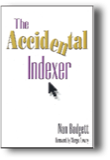 The Accidental Indexer is a great all-in-one book covering the many facets of an indexing career and the profession as a whole. It's an easy and entertaining read, yet the book is packed with information for those considering an indexing career, beginning indexers, and more seasoned indexers alike.
The Accidental Indexer is a great all-in-one book covering the many facets of an indexing career and the profession as a whole. It's an easy and entertaining read, yet the book is packed with information for those considering an indexing career, beginning indexers, and more seasoned indexers alike.
Badgett begins by addressing just what indexing is and how one gets started doing it, including a suitability quiz for aspiring indexers. Everything needed to establish an indexing career is covered such as how to get training, starting a business, insurance and taxes, setting up an office, software and equipment, information resources, marketing, and working with clients. An appendix includes several sample business forms that readers can adapt to their own use.
Chapter 3 discusses the many types of indexing and gives an overview of indexing print books, periodicals, databases, ebooks and electronic documents, and Web sites. Badgett also describes the various segments of the book publishing industry that hire indexers. Another quite helpful chapter is about achieving excellence, and describes, besides training, best practices and indexing award criteria. A corresponding appendix includes a concise list of quality indexing benchmarks, and guides to editing and evaluating an index.
Seasoned indexers will especially appreciate Chapter 8 regarding work/life balance, certainly one of the most challenging aspects of a freelance lifestyle. Badgett makes suggestions for efficient use of time, setting office hours, and creating home office boundaries. She also touches upon stress management, diet and exercise, and ergonomics with useful additional resources listed at the end of the chapter.
Also interesting for more experienced indexers is a chapter about creativity in indexing work. Topics covered are entrepreneurial indexing, creative collaboration, subcontracting, and creative communication. There is even a section on incarcerated indexers!
Badgett concludes The Accidental Indexer with advice to follow your inner indexer in making decisions about starting an indexing career and lays out the first steps in starting a business. This book is highly recommended to anyone interested in any aspect of the indexing profession.
Jennifer Spanier
Jennifer Spanier has been a freelance book and database indexer since 2009 and is an active member of the American Society for Indexing. Previously she has worked as a biologist and a public librarian and indexes in a wide variety of subject areas.
The Glass Cage: Automation and Us
Nicholas Carr. 2014. New York, NY: W.W. Norton & Company. [ISBN 978-0-393-24076-4. 276 pages, including index. US$24.95.]
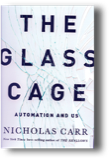 Nicholas Carr argues that the increasing power of automation lulls us into believing that such systems are infallible and that their feedback is always the most accurate. Ceding our control to the machine, we lapse into complacency and “learned carelessness” (p. 71) that numbs our ability to solve problems when the automated system cannot.
Nicholas Carr argues that the increasing power of automation lulls us into believing that such systems are infallible and that their feedback is always the most accurate. Ceding our control to the machine, we lapse into complacency and “learned carelessness” (p. 71) that numbs our ability to solve problems when the automated system cannot.
As Carr shows, such “automation addiction” results in the operator's “deskilling,” and can have serious, even catastrophic, consequences (pp. 58, 55). A prime example is the airline pilot who becomes overly dependent on automated flight controls and loses the ability to fly the plane based on practical experience or “know-how” (p. 74). In extreme cases, as in the 2009 Air France accident, the pilot may not know how to respond, with disastrous results.
Similarly, architects increase their efficiency by using “cut and paste” CAD designs, but their work becomes “banal, lazy and uneventful” (p. 147); travelers navigate more efficiently with GPS, but lose the spatial context and sense of orientation provided by paper maps; and doctors draw on immense statistical databases for diagnosis, but often miss less predictable signs of illness.
Automation is becoming “a system that discards us” (p. 198). We are essentially “disembodying ourselves” (p. 151), losing the “embodied cognition” necessary for a full human experience of the world (p. 149). To recover “embodied cognition,” we must learn to work with rather than for tools so that the human retains final control, not the machine. This balanced approach “binds us to the earth,” and nurtures our existential relationship to the world, but without losing the advantages of automation (p. 214).
One solution is to design “human centered automation” (p. 164) that requires explicit, conscious operator involvement as part of the overall system. Thus Boeing's new flight control systems compel conscious pilot involvement by mimicking traditional cable controls, keeping the pilot sensorily aware and in ultimate control of the plane's behavior at all times. In the same way, stylus-based CAD software preserves the architect's creativity by not immediately reformatting drawings according to predefined templates. In each case, the system does significant work, but the human remains continuously involved, responsive, and in control.
The Glass Cage: Automation and Us is well-documented, drawing upon classic academic studies such as Csikszentmihalyi's on “flow” and Yerkes-Dodson's on human performance, as well as recent work on the neurological mapping of spatial orientation and memory and Matthew Ebbatson's study of “'skill fade'” in pilots (p. 58), among others. Carr's book is also clearly written and highly readable, a notable achievement considering the technical and potentially very dry topic.
Automation is not going away, nor should it. As Carr convincingly argues, we must always give “people precedence over machines” (p. 228), lest we end up slaves to our own creations.
Donald R. Riccomini
Donald R. Riccomini is a member of STC and a lecturer in English at Santa Clara University, where he specializes in teaching engineering and technical communications. He previously spent twenty-three years in high technology as a technical writer, engineer, and manager in semiconductors, instrumentation, and server development.
Qualitative Text Analysis: A Guide to Methods, Practice & Using Software
Udo Kuckartz. 2014. Sage Publications Ltd. [ISBN 978-1-4462-6775-2. 174 pages, including index. US$48.00 (softcover).]
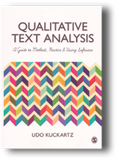 Among the extensive literature on qualitative data analysis, what distinguishes Qualitative Text Analysis: A Guide to Methods, Practice & Using Software is its concrete introduction to conducting qualitative data research. Realizing the challenges in the literature—imprecise descriptions of analysis process and diverse quality standards—Kuckartz strives for “methodical rigour” (p.11) to provide a systematic guide to qualitative data analysis and its implementation for beginners to qualitative research.
Among the extensive literature on qualitative data analysis, what distinguishes Qualitative Text Analysis: A Guide to Methods, Practice & Using Software is its concrete introduction to conducting qualitative data research. Realizing the challenges in the literature—imprecise descriptions of analysis process and diverse quality standards—Kuckartz strives for “methodical rigour” (p.11) to provide a systematic guide to qualitative data analysis and its implementation for beginners to qualitative research.
Using the example of guideline-structured interview texts, this book presents (1) theoretical underpinnings of qualitative text analysis (QTA), (2) basic concepts and the QTA process, (3) three principle QTA types, (4) QTA using computer-assisted methods, and (5) quality standards, research reports, and documentation.
Notably, Qualitative Text Analysis focuses only on category-based methods and analysis. In fact, working with codes and categories is central to the presented QTA theories and methods. It is important to differentiate between these category-based methods and sequential analysis methods (commonly used in discourse or narrative analysis).
QTA is built on the strengths of classical hermeneutics, grounded theory, and content analysis. It is a set of systematic rules for coding and creating categories based on all texts of the entire data, in which hermeneutic interpretation and reflection play a significant role; it also recognizes quality standards and aims for intercoder agreement.
Kuckartz describes three basic QTA methods in detail: thematic analysis, evaluative analysis, and type-building analysis. For each method, he elaborates the complete phases of analysis process, from working with the text, to building categories, to coding, to analyzing, to presenting results. Although many other guidebooks on qualitative research eliminate or briefly mention the last step, presentation of results, Qualitative Text Analysis considers it as an integral part and explicates seven types of presentation of results for each method. Kuckartz frequently uses lists, figures, and tables for illustrating key terms, steps, and rules. The example project, an interview about individual perception of climate change, which adopts all three methods for different research questions, also makes the description more comprehensible and practical. Special attention goes to the differences between individual and team researchers in coding and categorizing. Another important subject is how to use computer software to increase the quality of analysis. Kuckartz gives an overview of the assistance computer software can offer throughout the entire analysis process of the three methods mentioned above.
Overall, Qualitative Text Analysis‘s step-by-step structure and hands-on application make it a great starting point for both individual and team researchers interested in qualitative data analysis. However, since the methods described are exclusively designed for the data type “text,” one would need to modify the methods to analyze different types of qualitative data, such as images, movies, and other products of culture and communication.
Lin Dong
Lin Dong is a PhD candidate in Rhetoric and Composition in Georgia State University. She has broad research interests in cross-cultural and international rhetoric and communication, especially in technical and professional communication in the global contexts. Lin is currently preparing her PhD dissertation on international crisis communication from a sociotechnical aspect.
Designing News: Changing the World of Editorial Design and Information Graphics
Francesco Franchi. 2013. Berlin, Germany: Gestalten. [ISBN 978-3-89955-468-7. 240 pages. US$78.00.]
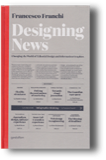 Is print dead? In Designing News: Changing the World of Editorial Design and Information Graphics, Franchi examines how the digital era is effecting editorial design. He looks at the issues that are causing newspapers to shut their doors after more than a hundred years of business. But why are some closing while others continue by restructuring and reformatting? And now with the Internet becoming a news source for a significant amount of our news, what can we learn from those that are successfully maintaining news sites and relaying information on various digital platforms? Franchi offers insights on how to handle the issues that challenge the very existence of newspapers in today's digital and technologically advancing world.
Is print dead? In Designing News: Changing the World of Editorial Design and Information Graphics, Franchi examines how the digital era is effecting editorial design. He looks at the issues that are causing newspapers to shut their doors after more than a hundred years of business. But why are some closing while others continue by restructuring and reformatting? And now with the Internet becoming a news source for a significant amount of our news, what can we learn from those that are successfully maintaining news sites and relaying information on various digital platforms? Franchi offers insights on how to handle the issues that challenge the very existence of newspapers in today's digital and technologically advancing world.
One problem with printed newspapers is that they cater to a select crowd. Your content must appeal to the buyer or you will not have a sale. Franchi says, “A printed newspaper is like a package. The reader who wants to read only about sports or only about the stock exchange has to buy the same newspaper as the reader who is interested only in politics, in recipes, or in horoscopes” (p. 21). With digital news platforms, readers can choose the articles and content that appeals to them. With these digital platforms and their problems, how do you get the reader to buy in? Some news sources are using a paywall, where some content is in front of the wall and available to anyone to access with the remaining content residing behind the wall that can only be accessed through purchase. The goal is to draw the reader in with quality content and leave them wanting more. The problem is the readers' attention span is lacking; many read one or two articles and then move on, bypassing the paywall.
Franchi shows that the power of design is the solution for these news sources to consider. Merely restyling the “look” of the paper is not enough to draw in the readers. Designing News shows us instead that design should be applied to the whole paper. Content and design go together; what the author refers to as “rethinking” is in fact the key. The abundance of information that is available must be made accessible to readers. This book argues that this can be done through careful design practices including well designed layout, well planned and quality content, information graphics, and through careful research and brand development; all are graphic designer talents.
Case studies of successful newspaper and news magazine redesigns throughout the text help illuminate the presented ideas. Designing News will appeal to anyone in editorial design, newspaper, magazine, and other formats. The issues that Franchi addresses bring to light a better understanding of the challenges that news sources struggle with and how to present their content. The solution to this struggle can be found in “questioning both the identity of the newspaper and its role in society” (p. 227).
Amanda Horton
Amanda Horton holds an MFA in Design and currently teaches graduate and undergraduate courses at the University of Central Oklahoma in the areas of design technology, design studio and history of graphic design. She serves as a book reviewer for Technical Communication.
Practical Empathy: For Collaborating and Creativity in Your Work
Indi Young. 2015. Brooklyn, NY: Rosenfeld Media. [ISBN 978-1-933820-48-4. 182 pages, including index. US$39.00 (softcover).]
 When you think of empathy, you probably think of emotions and feelings. Young's Practical Empathy: For Collaborating and Creativity in Your Work argues that there is a second kind of empathy: Cognitive empathy where you determine another person's thought processes. The value of using cognitive empathy is that you can understand others better than when using statistics, especially people you work with, including customers. She describes a method for developing cognitive empathy so that it can become, as the title suggests, practical.
When you think of empathy, you probably think of emotions and feelings. Young's Practical Empathy: For Collaborating and Creativity in Your Work argues that there is a second kind of empathy: Cognitive empathy where you determine another person's thought processes. The value of using cognitive empathy is that you can understand others better than when using statistics, especially people you work with, including customers. She describes a method for developing cognitive empathy so that it can become, as the title suggests, practical.
Young divides her book into three sections: the role of empathy (Chapters 1–3), developing empathy (4–5), and applying empathy (6–9). Starting with Chapter 4, Young adds a summary. Chapters 4 and 6–8 add practice suggestions. Section 1 begins with you listening to another person. Subsequent sections apply empathy to people you work with and then the organization. The last chapter points to your next steps.
The usefulness of Young's method depends on two factors: the number of people involved and the amount of time available. In daily interactions, for example, her suggestions about listening can be useful. Essentially, the listening session is about the other person. How do you manage to keep that focus? Keep yourself out of the conversation: what you might suggest, or ask about, or criticize, etc. The other person needs to be in charge. Your objective is to develop support for the other person, to be attentive so the other person knows that you are interested.
Empathy can have several uses. It can change beliefs or behavior, encourage growth, or better understand another person's reasoning, reactions, and guiding principles. The best approach to accomplish these goals is, after the listening session, to create a summary of what the other person says (an actual transcript is best). You then can analyze what the other person says and look for key points that give clues as to that person's thought processes. If you have quotes, summarize them, centering the summary on verbs.
Time versus value is an issue you want to resolve early in the process. To follow Young's complete process (interview, summary, extract quotes, build summary sentences starting with an appropriate verb, etc.) takes time. You can expect to review around 15 analyses in an hour. If you hold listening sessions with, for example, your team and you have 8 to 10 or more on that team, you are committing a large block of time if you follow the whole process. Yet when dealing with coworkers or customers, sympathetic empathy fails to produce the information you need to be a better manager or designer.
When your objective is to understand thought processes and you have the time, Young's method has value. However, you will need to adapt her approach to your specific situation and goals. The point of Practical Empathy is that this process humanizes interactions rather than relying on statistical approaches that dehumanize the situation.
Tom Warren
Tom Warren is an STC Fellow, Jay R. Gould Award for Excellence recipient, and professor emeritus of English (technical writing) at Oklahoma State University, where he established the BA, MA, and PhD technical writing programs. Past president of INTECOM, he serves as guest professor at the University of Paderborn, Germany.
A Century of Communication Studies: The Unfinished Conversation
Pat J. Gehrke and William M. Keith, eds. 2015. New York, NY: Routledge. [ISBN 978-0-415-82036-3. 308 pages, including index. US$49.95.]
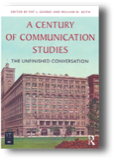 Recounting a particular discipline's history is more than just capturing stories and accomplishments before they are forgotten. As Gehrke and Keith point out, history can also “illuminate the past as well as the present” (p. 1), which is their intention behind putting together A Century of Communication Studies: The Unfinished Conversation. Beginning with the 1914 founding of the National Council of Teachers of English and reflecting on issues of importance, this volume uses this arbitrary date to celebrate a discipline that has undergone tremendous change over the past 100 years as a way to discern the contemporary state of the field and anticipate the future.
Recounting a particular discipline's history is more than just capturing stories and accomplishments before they are forgotten. As Gehrke and Keith point out, history can also “illuminate the past as well as the present” (p. 1), which is their intention behind putting together A Century of Communication Studies: The Unfinished Conversation. Beginning with the 1914 founding of the National Council of Teachers of English and reflecting on issues of importance, this volume uses this arbitrary date to celebrate a discipline that has undergone tremendous change over the past 100 years as a way to discern the contemporary state of the field and anticipate the future.
The book begins with a detailed introduction about disciplinary identity (who are “we”?), building the discipline, and then finding unity within a field that has numerous, diverse focus areas. The chapters cover subjects like recounting historical turning points within the discipline, analysis of scholarship, the scholarly communication of communication scholars, a history of sex/gender in communication studies, and cultural transformations within communication studies, such as the emergence of Black rhetoric, to name a few. Each chapter is impressive in the breadth of content, all which contain a well-researched historical perspective that traces the evolution of the subject matter to the present and concludes with grounded speculation about direction for future research and studies. For example, in “The Scholarly Communication of Communication Scholars,” Stephen points out that the information within communication studies like most disciplines has grown faster than scholars can keep up with, which “promotes fragmentation in the field” (p. 109). However, by analyzing the communication that takes place between communication scholars, individuals can position their own research in the field as well as plan a healthy, robust curriculum within individual academic departments. In this chapter, Stephen presented his study results that analyzed the publication productivity, focus areas, and structure of current scholarship in communication for the past century. In looking to the next 100 years, if change continues at its current rate, the field will be unrecognizable to those who know it today, and the issue of cohesion will remain a challenge for the entire field. Consequently, scholars must be prepared to map the many scholarship avenues “uniting scholars rather than risking their division into increasingly separated areas of research focus” (p. 123). Diversification and cohesion are relevant issues to any discipline, so it is helpful to see how communication studies have changed and yet remained intact during the historical timeline presented in this book.
Written by American communication scholars, A Century of Communication Studies focuses only on American communication studies. The intentional writing and tremendous research evidenced in each chapter are two of this book's most impressive aspects; thus, graduate students, scholars, and workplace professionals may find this book easily accessible and useful.
Diane Martinez
Diane Martinez is an assistant professor of professional and technical communication at Western Carolina University. She previously worked as a technical writer in engineering, an online writing instructor, and an online writing center specialist. She has been with STC since 2005.
Writing for the Web: Composing, Coding, and Constructing Web Sites
J. D. Applen. 2013. New York, NY: Routledge. [ISBN 978-0-415-88326-9. 316 pages, including index. US$110.00 (softcover).]
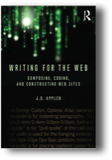 Writing for the Web: Composing, Coding and Constructing Web Sites effectively teaches beginners the basics for producing Web sites. Applen wrote the book for classroom use.
Writing for the Web: Composing, Coding and Constructing Web Sites effectively teaches beginners the basics for producing Web sites. Applen wrote the book for classroom use.
The media theory chapter contains thought-provoking questions that instructors can use for discussion questions or short essay prompts. Chapters two through five include exercises at the end of most sections. Chapter six gives two cumulative projects: a personal Web site project and an informational Web site project. Applen provides sample projects to guide readers. The book's Web site has support materials for instructors and the media files used in the book's examples. Instructors can rearrange the chapter order based on their preference.
The HTML chapter reviews HTML's history, the W3C, and how HTML differs from XHTML and XML (the book teaches XHTML conventions). With plenty of examples and screenshots, Applen explains absolute and relative links, mailto links, anchor links, image maps, and tables. He provides other important information for Web site management: how to save files; how to manage files, folders, and pathways; and how to validate code. I easily followed the chapter's organization.
The CSS chapter explains document/internal CSS, inline CSS, and external CSS, listing the benefits of each. Applen then defines classes, IDs, spans, divisions, and pseudo classes. The next section lists layout techniques from simple to complex. The chapter concludes with alphabetic links, breadcrumbs, tier-system Web site organization, FTP, and metatags. The examples and exercises in the HTML and CSS chapters solidify Applen's lessons.
Both unskilled writers and skilled writers with minimal Web-writing experience benefit from the chapter on rhetoric and writing. Applen teaches punctuation rules, style considerations, MLA citation style, and audience analysis. The rhetoric section discusses ethos, logos, pathos, and kairos in depth, relating each term to Web writing. Applen includes sections specifically for Web writing, such as a section on copyright, fair use, and public domain.
Chapter five discusses Web page layout and Web site organization. Applen suggests how to improve readability with white space, screen length, and margins. When discussing Web site organization, Applen uses screenshots from the Mayo Clinic Web site to show organizing strategies and to explain the purposes of home pages and pathway pages. The screenshots provide concrete examples that elucidate Applen's words.
Applen claims that people who produce Web sites must assume four competent roles as a media theorist, a technician, a rhetorician, and a writer. As a writer who knew little about writing for the Web, I give Applen's book an A–. I noticed a few typos in the code, and I had to reread a number of unclear paragraphs. But overall, Writing for the Web gave me a solid understanding of how to produce Web sites.
Alex Boren
Alex Boren has a BS in University Studies from the University of Utah, where he designed an interdisciplinary philosophy degree program. He volunteers as a grant proposal writer for the non-profit Clean Trails and is building his technical writing Web folio.
Scientific Writing and Communication: Papers, Proposals, and Presentations
Angelika H. Hofmann. 2014. 2nd ed. New York, NY: Oxford University Press. [ISBN 978-0-19-994756-0. 728 pages, including index. US$39.95 (softcover).]
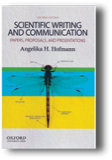 Scientific Writing and Communication: Papers, Proposals, and Presentations takes on the large task of covering the gamut of scientific communications: preparing and writing manuscripts, grant proposals, posters, and job applications, as well as giving oral presentations. The two largest sections are those on writing manuscripts and grant proposals, and third in size is the section on writing basics like word choice, sentence structure, paragraphs, and English-as-a-second-language (ESL) concerns. The advice Hofmann gives is generally sound, although the coverage of topics obviously can't be comprehensive, even in 728 pages.
Scientific Writing and Communication: Papers, Proposals, and Presentations takes on the large task of covering the gamut of scientific communications: preparing and writing manuscripts, grant proposals, posters, and job applications, as well as giving oral presentations. The two largest sections are those on writing manuscripts and grant proposals, and third in size is the section on writing basics like word choice, sentence structure, paragraphs, and English-as-a-second-language (ESL) concerns. The advice Hofmann gives is generally sound, although the coverage of topics obviously can't be comprehensive, even in 728 pages.
The multitude of exercises and problems in each chapter, such as rewriting sentences for active voice, choosing correct word forms within sentences, constructing a paragraph from a list of facts, and analyzing grant abstracts for the needed elements are a notable strength. The “Answer Key” provides 60 pages of suggested solutions to the problems. The book also contains innumerable examples followed by revisions that improve on the original. These features should be particularly useful to ESL writers. The examples and problems are mainly from the biological and biomedical disciplines.
I found Scientific Writing and Communication‘s structuring of information hard to follow. Part I, Scientific Writing Basics, presents 30 “rules” about details of English grammar, diction, and structure. Yet it also contains some 18 “guidelines,” and I never found a statement of the difference between the two. Surely, “Ensure that every sentence has a subject” (Part I, p. 87) should not be a mere guideline. Part II of the book contains over 40 guidelines, but no rules. Parts III to V contain “structural guidelines” for various topics, such as 10 guidelines for abstracts in Part III and 27 guidelines for oral presentations in Part V. I did wonder whether so many individual instructions are a help or a hindrance to the reader trying to apply all this advice to the actual writing process.
Too many editorial misses mar the book's presentation and value. Rule 2, “Use precise words,” on pp. 12–13, has three examples and revisions. The accompanying discussion states that “enhanced” is an imprecise and wrong word choice, but that word is not in any of the examples. Section 4.9 is “Lists and Comparisons” but treats only lists; Section 4.10 is “Faulty Comparisons.” While punctuation point 8 (p. 70) states “Avoid quotation marks,” the text below tells how to use them correctly—so why not drop “avoid” from the head? On p. 64, the advice is to spell out “percent” in formal writing and use “%” in informal, but science and engineering authors routinely use the percent sign. Lastly, the unit abbreviation for hour is “h” and for day is “d”; both should be used correctly with numeric values in a book on scientific writing.
The numerous examples and problems presented in Scientific Writing and Communication would be helpful to ESL readers, but overall, I would not recommend this book.
David Nadzjieka
David E. Nadziejka is the biomedical editor at the Van Andel Research Institute in Grand Rapids, MI, and an STC fellow. He has been a science and engineering editor for 25 years and has taught technical communication at the Institute of Paper Chemistry, Argonne National Laboratory, and Illinois Institute of Technology.
Josef Müller-Brockmann: Poster Collection 25
Bettina Richter and Museum für Gestaltung Zürich, eds. 2014. Zürich, Switzerland: Lars Müller Publishers. [ISBN: 978-3-03778-392-4. 96 pages, including catalogue. US$40.00 (softcover).]
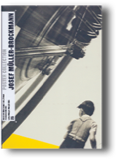 Josef Müller-Brockmann: Poster Collection 25 offers a succinct account of the objective clarity of Müller-Brockmann's individual methodology and approach to design problem solving through his extraordinary body of poster designs. This book has a rich source of posters reflecting an early illustration style to a purity of graphic form and evolving design sensibility reflecting the mid-19th century to present day. As Richter notes, “it was not the idea to make a catalogue raisonné of all his posters, but to show his development from illustration to concrete posters and to focus on the construction of Swiss Style in his work” (pp. 6–11).
Josef Müller-Brockmann: Poster Collection 25 offers a succinct account of the objective clarity of Müller-Brockmann's individual methodology and approach to design problem solving through his extraordinary body of poster designs. This book has a rich source of posters reflecting an early illustration style to a purity of graphic form and evolving design sensibility reflecting the mid-19th century to present day. As Richter notes, “it was not the idea to make a catalogue raisonné of all his posters, but to show his development from illustration to concrete posters and to focus on the construction of Swiss Style in his work” (pp. 6–11).
Müller-Brockmann, a leading theorist, educator, and practitioner of postwar Swiss Style, was one of the 20th century's most influential, prolific voices in graphic design. The Swiss School, also called “International Style,” materialized from Switzerland as a singular, uniquely clear graphic language and design movement during the 1950s and 1960s. The “Neue Grafik” or “Swiss Style,” originated in Russia, Germany, and the Netherlands during the rebellious cultural and political turbulence of the 1920s. This style was invigorated by artistic expression in avant-garde movements and the major architectural “International Style” that developed during this period in Europe and continued into the 1930s.
The book traces the origins of Müller-Brockmann's poster development sequenced chronologically over a 25-year period. Two essays, “In Public Space” by Lars Müller and “The Grid of History” by Catherine de Smet explain Müller-Brockmann's work in the public realm and central role in disseminating Swiss design in his writing and publishing activity. Each essay helps frame and place Müller-Brockmann's oeuvre and publications in a historical context and reflect the spirit of the times.
The Museum für Gestaltung–Schaudepot's poster collection is an all-inclusive, remarkable archive of the poster's history in Switzerland and throughout the world beginning in the 19th century to the contemporary era. In Richter's words, “It was always the idea to find a way to show the treasures of our collection with about 350,000 posters arranging them by themes, graphic designers and so on and to illustrate not only graphic design questions but also looking at posters as a part of a cultural and historical heritage. We tried to find a layout which give us in a pattern easily to copy for every new book a possibility to show large images and groups of posters” (pp. 32–33).
Josef Müller-Brockmann: Poster Collection 25 is a captivating, concise historical analysis, accompanied by many examples of Müller-Brockmann's extensive body of poster designs. This must-have book reveals how Müller-Brockmann's expressive style through objective clarity, mathematically constructed grids, modernist elements, and constructivist ideals remains an all-important part of our present-day graphic language. It is an indispensable guide for design students interested in Swiss typography as well as essential reading for professional designers, or anyone interested in 20th century graphic design history.
Richard B. Doubleday
Richard B. Doubleday is an assistant professor in the Department of Graphic Design at Louisiana State University's School of Art. He is a contributing author for Ornament and Initial: Beauty of Graphic Design, 17-20th Century, Phaidon Archive of Graphic Design, and Meggs' History of Graphic Design.
Revising and Editing for Translators
Brian Mossop. 2014. 3rd ed. New York, NY: Routledge. [ISBN 978-1-909485-01-2. 254 pages, including index. US$42.95 (soft cover).]
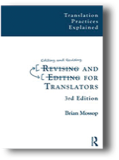 Revising and Editing for Translators is part of the “Translation Practices Explained” textbook series. That series is for students in university-level translation programs. The book explains the entire process of changing a translated text—from what editors and revisers do through the different types of editing and revision, the parameters to consider when revising a text and on to recommended procedures. Each chapter concludes with suggestions for practice and a set of related exercises.
Revising and Editing for Translators is part of the “Translation Practices Explained” textbook series. That series is for students in university-level translation programs. The book explains the entire process of changing a translated text—from what editors and revisers do through the different types of editing and revision, the parameters to consider when revising a text and on to recommended procedures. Each chapter concludes with suggestions for practice and a set of related exercises.
This is the latest edition, yet the section on computer aids for revision and editing tasks discusses in detail how to use various review features in Microsoft Word 2007. By now, most professionals have moved on to newer versions of that program. I recommend a change to this chapter in the next edition to discuss the review features in word processing programs and not reflect a newer version of Word. The university professor can always add more instructions.
Although Revising and Editing for Translators was written as a textbook, professional translators will also find Mossop's explanation of different types of editing, as well as the various considerations that (should) go into editing one's own work or that of a colleague interesting. I realized that many of my practices during revision were based on theoretical principles I had never really thought about. Those of us who have never been formally trained in translation theory can use this book—and perhaps other books in the series—to catch up on some of the foundations of our profession.
That said, many of the considerations and processes Mossop proposes are simply too time-consuming for practicing translators who need to meet often tight deadlines. He does acknowledge the time constraints under which we work and suggests that his best practices may not always be followed. Mossop's discussion of different levels of quality and the fact that top quality takes time, but is not always necessary, can be quite helpful during client negotiations. Similarly, the chapters on revision procedures and the differences between revising one's own work and that of others may well cause some of us to re-think how we approach such tasks.
Overall, the book is a worthwhile read for translators who have worked in the profession for many years, but it is even more helpful for those who are new to translation or are, in fact, still students.
Barbara Jungwirth
Barbara Jungwirth owns reliable translations llc (www.reliable-translations.com) where she translates technical documents from German into English. She was previously a technical writer and IT manager, and currently serves on the board of STC's New York Metro chapter. Barbara writes a blog (On Language and Translation) and tweets (@reliabletran).
Health Communication: Theory, Methods, and Application
Nancy Grant Harrington, ed. 2015. New York, NY: Routledge. [ISBN 978-0-415-82454-5. 504 pages. US$63.95 (softcover).]
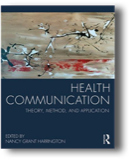 Health Communication: Theory, Methods, and Application is a textbook authored by academics and doctoral candidates in various health communication fields. Editor Nancy Grant Harrington, PhD states in the preface that she hopes the text fills the gap in information meant for undergraduates in upper-division health communication courses (p. xx).
Health Communication: Theory, Methods, and Application is a textbook authored by academics and doctoral candidates in various health communication fields. Editor Nancy Grant Harrington, PhD states in the preface that she hopes the text fills the gap in information meant for undergraduates in upper-division health communication courses (p. xx).
The book's organization and topics covered are the main strengths. There are 16 chapters on key health communication topics, starting with basic topics such as “The Patient Experience,” and moving on to more specific topics like “Mental Health and Illness” and “Internet and eHealth.” Each topic can stand on its own as a unit, and academics teaching these courses could easily use additional readings and films to support the topics.
The chapters are structured in a clear manner, with headings to identify the main topics. Key terms are highlighted and placed inside text boxes. Most of the chapters begin with a discussion of the main concepts and theories, and then move to case studies and specific examples of these concepts at work. A few chapters, such as “Understanding Caregiver Challenges and Social Support Needs,” were more difficult to read because they contained too many examples and skipped back and forth, presenting one or more case studies, interrupting a case study to present a key concept, and then returning to the original case study without a clear transition. These chapters read more like a literature review for an academic article rather than a textbook chapter.
The chapter review questions at the end are an asset. These exercises contain complex, but valuable topics for projects or short papers that ask the students to apply what they have learned to a real situation involving health communication.
The chapters are well written as a whole, but they are inconsistent in tone. Although Harrington states that she strove for an “engaging, even humorous style” (p. xxi), only the chapters co-written by Harrington demonstrate any attempt to adhere to this style. The remaining chapters tend to use plain language and a factual tone. As an academic coming from the technical communication field, I actually preferred these matter-of-fact chapters more, since they are easier to understand and contain fewer distracting tangents. I suspect that my students would feel similarly, since much of the text's humor depends heavily on references from pop culture that some students may not be familiar with, such as dated movie and music references and advertising jingles.
As an academic who is planning to teach an undergraduate health communication course, I was particularly interested in this textbook. I believe that Harrington met her goal of creating a timely, accessible book for upper-level students. Despite its drawbacks, Health Communication is a book that I would feel comfortable adopting for this purpose because of its strong organization and the importance and timeliness of the topics covered outweigh the inconsistencies.
Nicole St. Germaine-Dilts
Nicole St. Germaine-Dilts is an associate professor in the Technical and Business Writing Program at Angelo State University. Her research interests include technical communication for a Mexican–American audience and technical communication in the health fields.
Nicely Said: Writing for the Web with Style and Purpose
Nicole Fenton and Kate Kiefer Lee. 2014. San Francisco, CA: Peachpit Press. [ISBN 978-0-321-98819-5. 184 pages, including index. US$29.99 (softcover).]
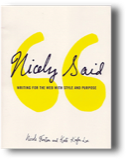 Nicely Said: Writing for the Web with Style and Purpose is a basic primer on creating content for various online purposes. As such, a reader learning to write Web copy can use this book to help create a foundation for Web writing principles. More experienced readers can use it as a refresher; the Web writing principles remain constant, and brushing up on them is a useful exercise. It's easy to choose among the topics covered because authors Fenton and Lee list the subjects of each chapter on the first page.
Nicely Said: Writing for the Web with Style and Purpose is a basic primer on creating content for various online purposes. As such, a reader learning to write Web copy can use this book to help create a foundation for Web writing principles. More experienced readers can use it as a refresher; the Web writing principles remain constant, and brushing up on them is a useful exercise. It's easy to choose among the topics covered because authors Fenton and Lee list the subjects of each chapter on the first page.
As the authors point out correctly, writing is not the first step in the writing process. They speak from experience—they are both professional writers and editors who teach others their skills. They guide readers through the preliminaries of planning and research necessary for getting to the writing stage. Throughout Nicely Said, Fenton and Lee reinforce the importance of understanding the writer's audience and keeping these “real people” at the center of all planning and writing. Their advice on writing is to keep it “clear, useful, and friendly” (p. 43). In my opinion, this is the best advice any Web writer can receive. The authors provide many examples of how to do this, while demonstrating how to establish a tone and style for a Web site or blog, and give examples of content that needs special handling, such as help documents and unsubscribe confirmations.
Fenton and Lee take their own advice by writing clearly and laying out their book in such a straightforward way that whether you are a “writer, editor, blogger, content strategist, designer, developer, or small business owner” (p. vii), you will breeze right through it. Nicely Said will give you some tools and overarching ideas about building a Web presence, using social media, creating interfaces that make sense, and marketing and selling online, but does not provide enough details to complete a Web site. This is primarily a guide to creating “useful and meaningful web content” (p. vii).
While Fenton and Lee talk about the importance of developing a style early on, they don't discuss style guides until the last chapter. I would have preferred to see the use of a style guide included as part of the planning and writing process instead of treated as a kind of overlay to the finished product. As the authors themselves confirm, such guides contribute to consistency and clarity, and are beneficial from the beginning of the process.
Fenton and Lee created an imaginary online bookstore that works well for demonstrating techniques they introduce throughout Nicely Said. Contemporary real-world examples are scattered throughout the book as well, sometimes in the form of sidebar stories. A bibliography is a useful addition to Nicely Said.
Linda M. Davis
Linda M. Davis is an independent communications practitioner in the Los Angeles area. She holds an MA in Communication Management and has specialized in strategic communication planning, publication management, writing, and editing for more than 25 years. Linda is active in the STC Los Angeles chapter.
Content Audits and Inventories: A Handbook
Paula Ladenburg Land. 2014. Laguna Hills, CA: XML Press. [ISBN 978-1-937434-38-0. 138 pages, including index. US$24.95 (softcover).]
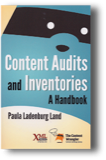 Paula Land's book, Content Audits and Inventories: A Handbook, provides an excellent tutorial on this critical content strategy step. As she aptly puts it, spending time up front avoids potentially disastrous implementations (p. xvi, paraphrased). If you don't know where you currently are, it's very difficult to plan a path to where you want to be.
Paula Land's book, Content Audits and Inventories: A Handbook, provides an excellent tutorial on this critical content strategy step. As she aptly puts it, spending time up front avoids potentially disastrous implementations (p. xvi, paraphrased). If you don't know where you currently are, it's very difficult to plan a path to where you want to be.
While Land focuses only on Web content, and neglects to mention user documentation, many of the techniques apply to any content type, with some modification. This book is a practical, customer- and business goals-focused guide to conducting content audits and inventories. As Land emphasizes, you need to focus on what's realistic and meet your business goals, while looking for quick wins to build engagement.
She provides several tips on saving money during the audit process, such as “quick and dirty” usability testing using a couple of users to test aspects of the customer journey; taking a cross-section of related content to review instead of trying to look at everything; and looking behind the data to understand why a page might not be getting the views it should by balancing bounces against time on the page. In each chapter, she includes resources and ideas for being efficient, while emphasizing that “an audit is not a one-time project, but a repeatable and regularly scheduled process” (p. xiv).
If there are any content weaknesses in Content Audits and Inventories, it's in Chapter 12, “Auditing for Global Issues.” One of her examples, the infamous Chevy Nova story, is an urban legend and is not real. Nitish Singh and his coauthor were describing the work of Geert Hofstede in their work, yet the book does not cite Hofstede. This chapter could also do more to discuss examining the localization process as part of the audit, and the importance of integrating localization into the content creation process. Throughout the book, some of the graphics are a bit difficult to read (especially the one with a blue background and white text in Appendix E), but these are minor distractions.
The resources in the appendices alone are worth the book's price. This book goes on my must-have bookshelf for anyone interested in content management, content strategy, or information architecture, as well as anyone facing a major content management system or Web site retooling.
Though the Content Audits and Inventories doesn't push Land's cloud-based tool known as CAT, this tool (or one like it) should be in every Web manager's toolbox because it takes the drudgery out of the content inventory and automates it.
Katherine (Kit) Brown-Hoekstra
Katherine Brown-Hoekstra, of Comgenesis, LLC, is a Fellow and current immediate past president for STC, speaks at conferences worldwide, and has authored many articles on various topics related to technical communication and internationalization. She has a background in life sciences and 25+ years of experience. She also coauthored a book on managing virtual teams.
KISS MY (?) Asterisk: A Feisty Guide to Punctuation and Grammar
Jenny Baranick. 2014. New York, NY: Skyhorse Publishing. [ISBN 978-1-62873-750-9. 168 pages, including index. US$14.95 (softcover).]
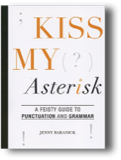 KISS MY (?) Asterisk: A Feisty Guide to Punctuation and Grammar is about avoiding basic grammar errors that confuse readers, that make writers look uneducated, and that undermine writers' confidence. This book is not for those looking for in-depth or obscure grammar rules; it is more like a refresher for experienced writers and a good introduction to show non-grammarians how to write more clearly using grammar rules.
KISS MY (?) Asterisk: A Feisty Guide to Punctuation and Grammar is about avoiding basic grammar errors that confuse readers, that make writers look uneducated, and that undermine writers' confidence. This book is not for those looking for in-depth or obscure grammar rules; it is more like a refresher for experienced writers and a good introduction to show non-grammarians how to write more clearly using grammar rules.
In her teaching career, Baranick sees the common grammatical errors that writers inject and addresses those in her book. She uses a conversational tone, making it seem as though you both are sitting at a table over coffee or tea, while she intimately discusses those errors and how not to make them in the future.
As the title suggests, this book is irreverent, yet relevant. Baranick sometimes uses slightly off-color humor to present grammar and punctuation rules and tips. KISS MY (?) Asterisk is not for readers who are squeamish about examples based on morality lapses or the use of mild profanity. All other readers will most likely engage in a chuckle or two while witnessing grammar come alive through vivid and fun examples. It might be prudent for those who may not like the examples to get a copy from the library first to see if the book is usable. If you find that it is, then purchase a copy that will most likely become dog-eared and marked up. Not all examples are potentially offensive; many are just plain entertaining.
You may be familiar with a few of her examples from the 1960s and 1970s (hint—watch reruns of “Gilligan's Island”); other examples are more current. To help you remember these particular grammar rules and tips, she brings in an eclectic group, including the gang on “Gilligan's Island,” Juliet Capulet, fairy tales, the cast of “Friends,” Paris Hilton, and more.
It is not necessary to read KISS MY (?) Asterisk from front to back, but Baranick does occasionally refer to previously mentioned explanations or examples. There are 17 chapters, each one covering a specific aspect or group of items, like “More than a Feeling: Commas” (Chapter 5), “Goldilocks and the Three Bears: En Dashes, Em Dashes, and Hyphens” (Chapter 8), and “Looks Matter: Formatting Academic Papers, Letters, and Résumés” (Chapter 16). Baranick includes practice exercises at the end of each chapter with the first exercise being a mini-crossword puzzle. You will find an answer key to the exercises near the end of the book.
Sherry Shadday
Sherry Shadday works for Southwest Research Institute in Utah as a principal technical specialist in configuration management and software engineering test documents. An STC member, she retired from the U.S. Air Force as an aircraft electrical systems maintainer and has a technical communication master's degree from Utah State University.
Does Your Content Work? Why Evaluate Your Content — and How to Start
Colleen Jones. 2014. San Francisco, CA: Peachpit Press. [ISBN 978-0-13-376507-6, 58 pages. US$15.00 (E-book).]
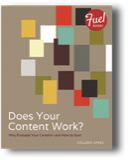 Does Your Content Work? Why Evaluate Your Content — and How to Start is a how-to book that helps readers discover if their content is truly effective. Throughout this book, readers learn how to evaluate if content is working for users. Jones gives readers a walk-through on the evaluation process and shows how to set goals for your Web site. Starting with business goals helps the readers frame why those goals are important in measuring the content experience.
Does Your Content Work? Why Evaluate Your Content — and How to Start is a how-to book that helps readers discover if their content is truly effective. Throughout this book, readers learn how to evaluate if content is working for users. Jones gives readers a walk-through on the evaluation process and shows how to set goals for your Web site. Starting with business goals helps the readers frame why those goals are important in measuring the content experience.
Jones continues by stating the importance of understanding quantitative data (user interviews, surveys, usability testing) and how to evaluate the data you receive. She continues with how qualitative data is not an effective way to emulate content over time. After finding this user information, many tend to overinterpret or underinterpret the data. Jones gives examples of the common mistakes and leads readers into what to do to evaluate the information properly.
Does Your Content Work wraps up the book with the idea that content evaluation is never done. Jones gives two courses of action in which to choose. One is to “confirm and continue” (p. 48), in which if something works to continue without changing it, and if something isn't working, you'd find a way to fix it. The second being “adjust or optimize,” in which you decide that you want to try to test new content types to try to make the user experience better (p. 48). Jones mentions using A/B testing if you want to compare two different content types with users. This lets you compare different options with users to see which one performs better.
At the end of the book, readers have handy tools and resources to use when completing content evaluations. You can use these tools along the way to help track where users are from, how they enter your Web site, devices they use, or what they do once they arrive on the site. When completing an evaluation of your content, these tools can become useful when receiving data, compiling data, or implementing changes.
I enjoy how Jones provides tools and resources to look into for those who are learning about how to evaluate content and why it is important. Does Your Content Work has a sleek layout that is easy to scan and find sections you need when working with your Web site. Users can depend on the simplicity in style and the use of images to make it an easy read. This isn't a book you will use once and then never pick up again. You will return to this book throughout your journey when evaluating your Web sites' content and implementing changes.
Kristi Wiley
Kristi Wiley is currently a PhD student in Rhetoric and Writing at Michigan State University. She focuses her research on UX, content strategy, technical writing and editing, usability, and Information Architecture.
Technology Integration and High Possibility Classrooms: Building from TPACK
Jane Hunter. 2015. New York, NY: Routledge. [ISBN 978-1-138-78133-7. 204 pages, including index. US$49.95 (softcover).]
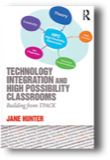 Hunter's book delivers what its title promises: an evaluation of integrating technology into classrooms that further develops the Technological Pedagogical Content Knowledge (TPACK) model as first presented in 2006 by Mishra and Koehler. A solid, but brief, justification for another book on technology integration greets the reader. Hunter explores general technology trends in Australia, the United States, the United Kingdom, South Korea, and Singapore, and situates the reader with a sense of common technology-related challenges and practices in diverse educational systems.
Hunter's book delivers what its title promises: an evaluation of integrating technology into classrooms that further develops the Technological Pedagogical Content Knowledge (TPACK) model as first presented in 2006 by Mishra and Koehler. A solid, but brief, justification for another book on technology integration greets the reader. Hunter explores general technology trends in Australia, the United States, the United Kingdom, South Korea, and Singapore, and situates the reader with a sense of common technology-related challenges and practices in diverse educational systems.
The second chapter provides the theoretical basis of Hunter's work. She covers how technological, pedagogical, and content knowledge differ as well as how they blend with each other, for example when technological and pedagogical or content and pedagogical overlap. Hunter then discusses what TPACK looks like when all the knowledges are applied together. Her presentation builds on existing resources, such as the tpack.org Web site, and Mishra and Koehler's own explanations in their original 2006 article and 2008 introduction to TPACK in the Handbook of Technological Pedagogical Content Knowledge. Next up is Substitution, Augmentation, Modification, and Redefinition (SAMR). This discussion is short; however, Hunter applies the SAMR lens regularly throughout the text. She shows how her own High Possibility Classrooms (HPC) framework builds on TPACK and SAMR.
Chapters three through six are case studies of four different classrooms and teachers and four different age groups: early years (K–2), elementary, middle, and high school. This approach is useful and practical in that it offers a different lens from the 2008 TPACK Handbook because that handbook focused on TPACK in specific content areas as opposed to grade levels. The grade-level emphasis also makes these chapters ideal for using apart from the whole text—especially for those teaching technology workshops or mentoring new teachers.
Chapter seven, “Creating High Possibility Classrooms,” reviews the HPC model and its component pieces. The chapter connects the HPC model's five key parts with larger theory and research; Hunter then connects each component to multiple case study examples. This discussion of connections also reviews the material presented for readers, allows for a holistic view of the HPC model, and demonstrates how HPC might appear in diverse grade levels.
Finally, Chapter eight covers how theory, creativity, public learning, life preparation, and contextual accommodation can help make HPC happen in schools worldwide. Faculty can use this chapter to help students better understand the relationship between theory and practice.
While Technology Integration and High Possibility Classrooms is meant primarily for teachers and teacher educators, TPACK can be readily adopted and used for higher education. What's needed is more extrapolation on how to apply the ideas and activities. Similarly, Hunter's HPC model is, like TPACK, one that higher educators can use to help in examining and improving their technology integration. Hunter's text is an excellent exemplar for faculty teaching case study research, educational technology, or how theory impacts practice.
Gregory Zobel
Gregory Zobel is an assistant professor of Educational Technology at Western Oregon University. Trained in technical communication, usability, and rhetoric, he supports and trains educators employing technology to enhance and enrich learner engagement, accessibility, and content delivery in person and online.

